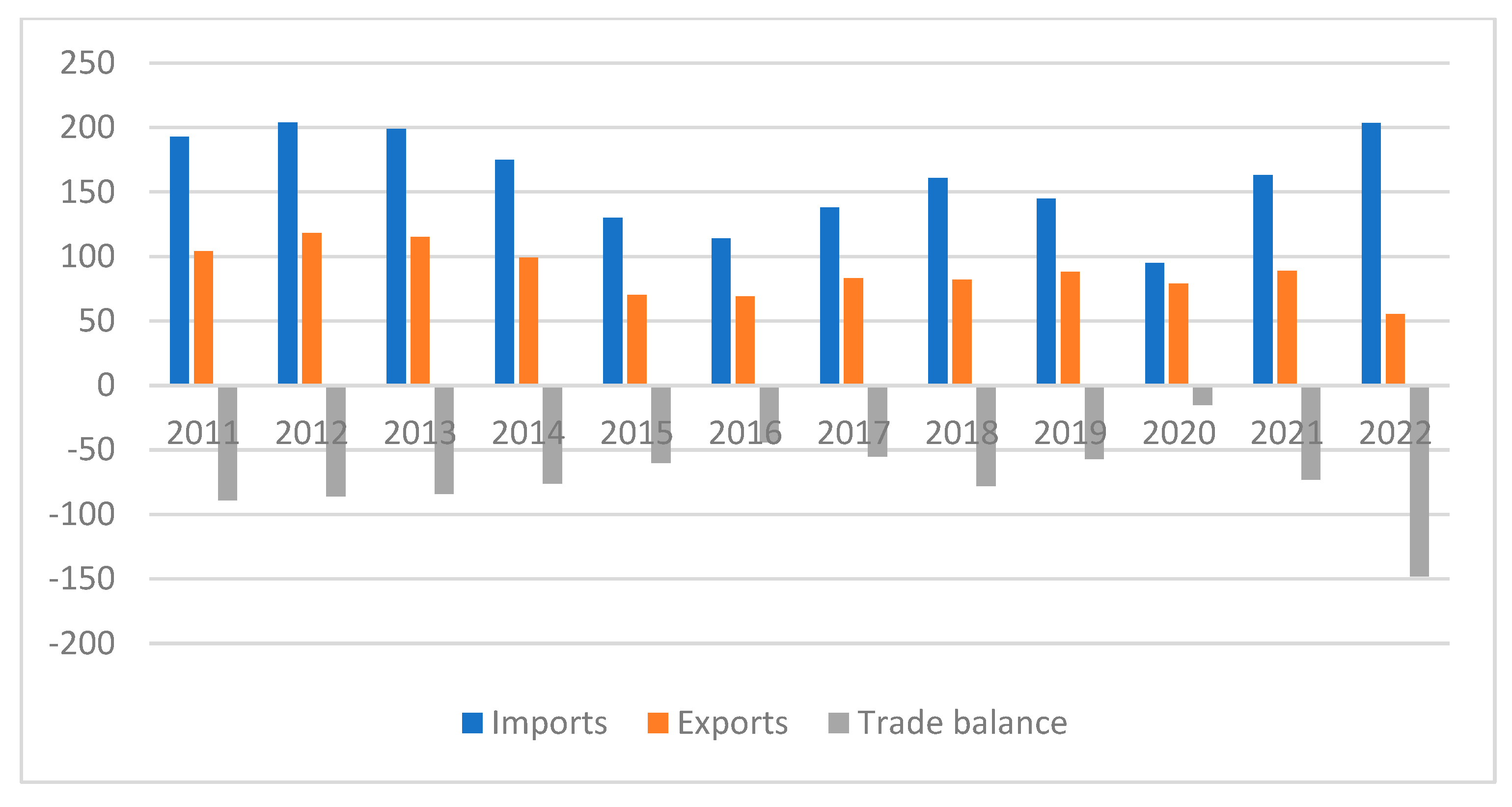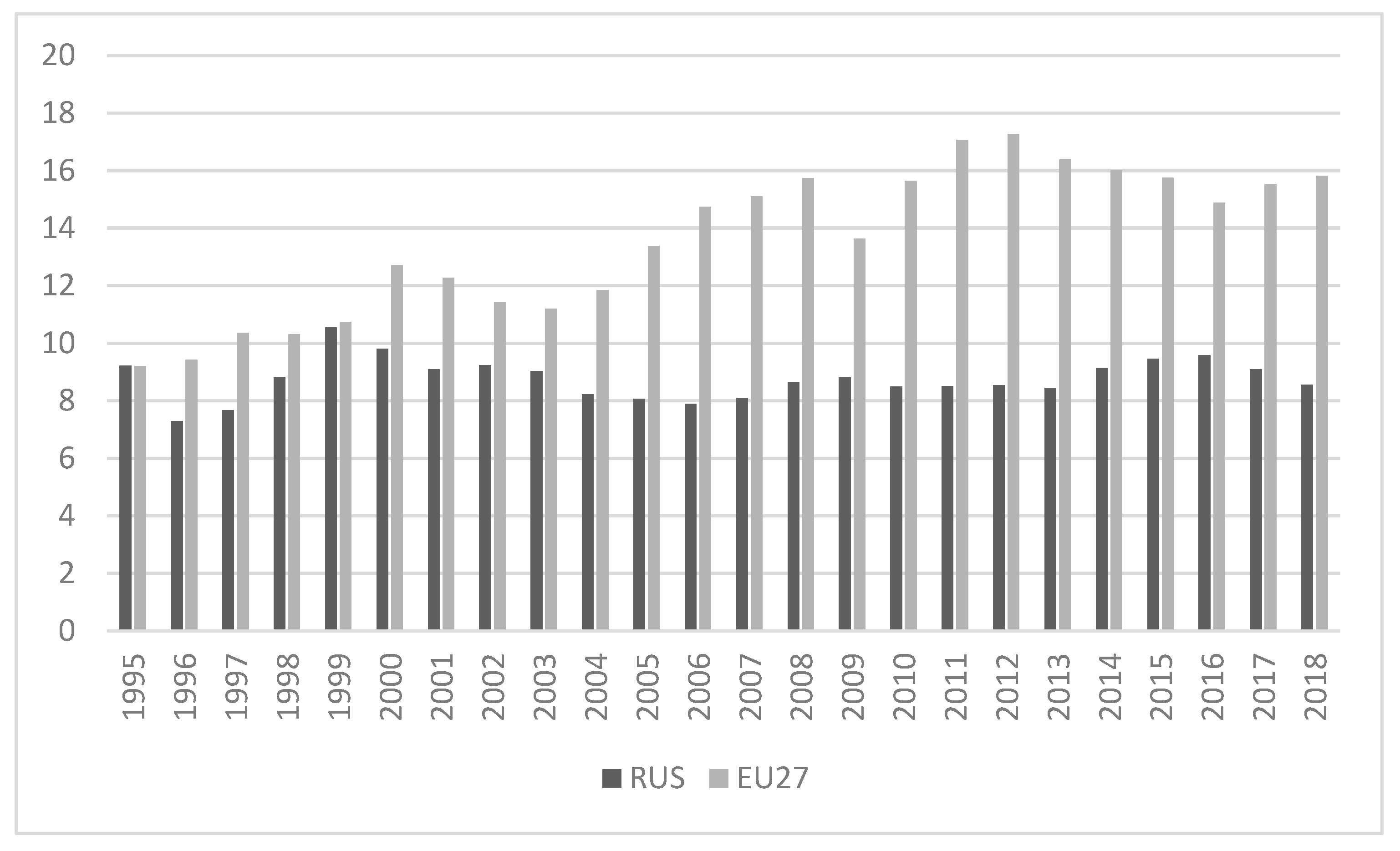Some Insights into the Bilateral Value Chains—The EU and Russia
Abstract
:1. Introduction
2. Literature Review
3. Trade Relations between the EU and Russia
- Sanctions against individuals and entities—assets freeze/travel ban
- Economic sanctions: finance, transport, energy, defence, raw materials, services
- Restrictions on media (European Council 2023).
4. Research
4.1. Methodology and Data
4.2. Results
5. Discussion and Policy Implications
Funding
Informed Consent Statement
Data Availability Statement
Conflicts of Interest
| 1 | A detailed list of implemented measures under 10 packages is explained by the European Council (2023). |
| 2 | The measurement includes comparison of national shares in global exports with national DVA shares in global DVA. If the share of national exports in global exports is lower than the share of national DVA in global DVA, it means the country has clear gains from trade in value added. |
| 3 | The forward GVC participation is calculated as the ratio between domestic export of intermediates and the value of other countries’ exports. Backward GVC participation is the ratio between imported intermediates from foreign countries and the value of domestic gross export (WTO 2021; OECD 2021; World Bank 2020). GVC participation is the sum of forward and backward participation. GVC participation = DVA/EXP + FVA/EXP (1), where DVA is the share of domestic value added (intermediate export) in foreign export, EXP is gross export, FVA is the share of foreign value added (intermediate import) in domestic exports. The data for DVA and FVA are taken from OECD (2013b, 2021) and GVC participation is calculated by the authors following the Formula (1). |
| 4 | Other countries intensively use Russian intermediates in their exports—forward participation. |
References
- Amador, João, Rita Cappariello, and Robert Stehrer. 2015. Global Value Chains: A View from the Euro Area. ECB Working Paper, No. 1761. Frankfurt: European Central Bank. [Google Scholar]
- BBC. 2023. What Are the Sanctions on Russia and Are They Hurting Its Economy? Available online: https://www.bbc.com/news/world-europe-60125659 (accessed on 18 June 2023).
- Borin, Alessandro, and Michele Mancini. 2019. Measuring What Matters in Global Value Chains and Value-Added Trade. Policy Research Working Paper, No. 8804. Bretton Woods: World Bank. [Google Scholar] [CrossRef] [Green Version]
- Chernova, V. Yu, Z. G. Golodova, E. A. Degtereva, A. M. Zobov, and V. S. Starostin. 2018. Russian industry in global value-added chains. European Research Studies Journal 21: 165–78. Available online: https://www.ersj.eu/dmdocuments/2018_XXI_3_12.pdf (accessed on 7 June 2023).
- Cieślik, Ewa, Jadwiga Biegańska, and Stefania Środa-Murawska. 2016. The intensification of foreign trade in post-socialist countries and their role in global value chains. Acta Oeconomica 66: 465–87. [Google Scholar] [CrossRef]
- Euronews. 2023. After 10 Rounds of Sanctions, How Much EU-Russia Trade Is Banned? Available online: https://www.youtube.com/watch?v=FDyNqWzDs1w (accessed on 7 February 2023).
- European Commission. 2022. A European Green Deal, Striving to Be the First Climate-Neutral Continent. Available online: https://ec.europa.eu/info/strategy/priorities-2019-2024/european-green-deal_en (accessed on 7 February 2023).
- European Council. 2023. Timeline—EU response to Russia’s Invasion of Ukraine. Available online: https://www.consilium.europa.eu/en/policies/eu-response-ukraine-invasion/timeline-eu-response-ukraine-invasion/ (accessed on 7 February 2023).
- European Parliamentary Research Service. 2022. Russia’s war on Ukraine: EU Trade Policy. Available online: https://epthinktank.eu/2022/05/16/russias-war-on-ukraine-eu-trade-policy (accessed on 7 February 2023).
- Eurostat. 2022. Energy Represented 62% of EU Imports from Russia. Available online: https://ec.europa.eu/eurostat/en/web/products-eurostat-news/-/ddn-20220307-1 (accessed on 7 February 2023).
- Eurostat. 2023. EU Trade with Russia—Latest Developments. Available online: https://ec.europa.eu/eurostat/statistics-explained/index.php?oldid=558089 (accessed on 15 June 2023).
- Felbermayr, Gabriel, Hendrik Mahlkow, and Alexander Sandkamp. 2023. Cutting through the value chain: The long-run effects of decoupling the East from the West. Empirica 50: 75–108. [Google Scholar] [CrossRef] [PubMed]
- Fojtíková, Lenka, Eva Jančíková, and Petra Doleželová. 2022. Russian Participation in Global Value Chains. In The Handbook of the Arctic. Edited by Egor V. Pak, Artem I. Krivtsov and Natalia S. Zagrebelnaya. Singapore: Palgrave Macmillan. [Google Scholar] [CrossRef]
- Gereffi, Gary, and Karina Fernandez-Stark. 2011. Global Value Chain Analysis: A Primer. Center on Globalization. In Governance & Competitiveness (CGGC). Durham: Duke University. [Google Scholar]
- Hernández, Virginia, and Torben Pedersen. 2017. Global value chain configuration: A review and research agenda. Business Research Quarterly 20: 37–150. [Google Scholar] [CrossRef]
- Javorsek, Marko, and Ignacio Camacho. 2015. Trade in Value Added: Concepts, Estimation and Analysis. ARTNeT Working Paper Series No. 150. Bangkok: ESCAP. [Google Scholar]
- Koopman, Robert, William Powers, Zhi Wang, and Shang-Jin Wei. 2010. Give Credit Where Credit Is Due: Tracing Value Added in Global Production Chains’. NBER Working Paper, No. 16426. Available online: http://www.nber.org/papers/w16426 (accessed on 7 January 2023).
- KSE. 2022. Self Sanctions/Leave Russia, Kyiv School of Economics. Available online: https://kse.ua/selfsanctions-kse-institute/ (accessed on 7 February 2023).
- Leitner, Sandra M., and Robert Stehrer. 2014. Trade Integration, Production Fragmentation and Performance in Europe—Blessing or Curse? A Comparative Analysis of the New Member States and the EU-15. WIIW Research Report No. 397. Vienna: The Vienna Institute for International Economic Studies(wiiw). [Google Scholar]
- Milov, Vladimir. 2022. Yes, It Hurts: Measuring the Effects of Western Sanctions Against Russia. Available online: https://www.globsec.org/what-we-do/press-releases/yes-it-hurts-measuring-effects-western-sanctions-against-russia (accessed on 7 February 2023).
- OECD. 2013a. Knowledge-based capital and upgrading in global value chains. In Supporting Investment in Knowledge Capital, Growth and Innovation. Paris: OECD Publishing, pp. 215–52. [Google Scholar]
- OECD. 2013b. Global Value Chains (GVCs): Russian Federation. Available online: https://www.oecd.org/sti/ind/GVCs%20-%20RUSSIAN%20FEDERATION.pdf (accessed on 7 January 2023).
- OECD. 2021. Trade in Value Added. Available online: https://stats.oecd.org/Index.aspx?DataSetCode=TIVA_2021_C1 (accessed on 7 January 2023).
- Sidorova, E. 2018. Russia in Global Value Chains. World Economy and International Relations 62: 71–80. [Google Scholar] [CrossRef]
- Simachev, Yuri V., Anna A. Fedyunina, and Yuliya V. Averyanova. 2020. Transformation of global value chains in Russia and the Baltics amid COVID-19: Prospects for regionalization and implications for economic policy. Baltic Region 12: 128–46. [Google Scholar] [CrossRef]
- Stephenson, S. 2013. Global Value Chains: The New Reality of International Trade’. E15Initiative; Geneva: International Centre for Trade and Sustainable Development (ICTSD) and World Economic Forum. Available online: http://www.e15initiative.org/ (accessed on 12 March 2023).
- Taglioni, Daria, and Deborah Winkler. 2016. Making Global Value Chains Work for Development. Washington, DC: The World Bank Group. [Google Scholar]
- Tajoli, Lucia. 2022. Too much of a good thing? Russia-EU international trade relations at times of war. Journal of Industrial and Business Economics 49: 807–34. [Google Scholar] [CrossRef]
- Timmer, Marcel P., Bart Los, Robert Stehrer, and Gaaitzen J. De Vries. 2016. An Anatomy of the Global Trade Slowdown Based on the WIOD 2016 Release. GGDC Research Memorandum, No. 162. Available online: http://www.ggdc.net/publications/memorandum/gd162.pdf (accessed on 7 January 2023).
- Vladimir, Varnavskii. 2019. The EU and Russia in Global Value Chains. Contemporary Europe 1: 92–103. Available online: https://www.imemo.ru/en/publications/info/es-i-rossiya-v-globalynih-tsepochkah-sozdaniya-stoimosti-5109 (accessed on 7 January 2023).
- Voanews. 2023. Russian Trade Rises Despite Sanctions, as NATO Member Turkey Offers ‘Critical Lifeline’. Available online: https://www.voanews.com/a/russian-trade-rises-despite-sanctions-as-nato-member-turkey-offers-critical-lifeline-/7128651.html (accessed on 17 June 2023).
- Volgina, Natalia. 2018. Russia in global value chains: Levels of participation and distribution gains: Towards sustainable economic development. In Exploring The Future of Russia’s Economy and Markets. Towards Sustainable Economic Development. Edited by Bruno S. Sergi. Bingley: Emerald. [Google Scholar] [CrossRef]
- WEF. 2022. How Much Energy Does the EU Import from Russia? Available online: https://www.weforum.org/agenda/2022/03/eu-energy-russia-oil-gas-import (accessed on 7 February 2023).
- Winkler, D., L. Wuester, and D. Knight. 2022. The Effects of Russia’s global value-chain participation. In The Impact of the War in Ukraine on Global Trade and Investment. Edited by Michele Ruta. Bretton Woods: World Bank, pp. 57–70. Available online: https://documents1.worldbank.org/curated/en/099750104252216595/pdf/IDU0008eed66007300452c0beb208e8903183c39.pdf (accessed on 7 February 2023).
- World Bank. 2020. World Development Report 2020, Trading for Development in the Age of Global Value Chains. Available online: https://www.worldbank.org/en/publication/wdr2020 (accessed on 8 May 2022).
- WTO. 2021. Global Value Chain Development Report—Beyond Production. Available online: https://www.wto.org/english/res_e/publications_e/gvcdevreport_bprod_e.htm (accessed on 5 January 2023).
- WTO. 2022. Russian Federation-Trade in Value Added and Global Value Chains. Available online: https://www.wto.org/english/res_e/statis_e/miwi_e/RU_e.pdf (accessed on 3 December 2022).




| Import from Russia-Bans on | Export to Russia-Bans on | Other-Bans on | |
|---|---|---|---|
| 1st package, 23 February 2022 |
| ||
| 2nd package, 25 February 2022 |
| ||
| 3rd package, 28 February 2022 |
| ||
| 4th package, 15 March 2022 | Ban on:
| ||
| 5th package, 8 May 2022 | Coal and other solid fossil fuels other goods such as wood, cement, seafood and liquor | Jet fuel and other goods | Ban on:
|
| 6th package, 30-31 May 2022 | Crude oil, petroleum products, delivered from Russia to member states. A temporary exception for crude oil delivered by pipeline will be introduced. |
| |
| 7th package (“Maintenance and alignment” package), 21 July 2022 |
|
| |
| 8th package |
| ||
| 9th package | Drone engines dual-use goods and technology |
| |
| 10th package | Asphalt and synthetic rubber | Critical technology and industrial goods |
|
| Bans on Import from Russia | Bans on Export to Russia | |
|---|---|---|
| Value in EUR bn | 91.2 | 43.9 |
| Share of total (%) | 58 | 49 |
| Products | Oil, coal, gold, steel, cement, rubber, vodka and caviar | Microchips, drones, trucks, chemicals, radio systems and banknotes |
| Prohibition of export of luxury products worth more than EUR 300 each |
| 1995 | 2000 | 2005 | 2010 | 2015 | 2018 | |
|---|---|---|---|---|---|---|
| Share of the FVA from the EU in the FVA of Russian final demand | ||||||
| Agriculture, hunting, forestry and fishing | 24.7 | 19.6 | 16.4 | 16.8 | 10.3 | 10.4 |
| Manufacturing | 33.3 | 45.9 | 42.2 | 39.2 | 32.9 | 34.5 |
| Computer, electronic and electrical devices | 23.2 | 47.4 | 42.9 | 31.7 | 23.0 | 23.7 |
| Transport equipment | 34.7 | 45.6 | 27.5 | 38.7 | 32.4 | 39.2 |
| Electricity, gas, steam and air conditioning supply | 35.3 | 39.5 | 41.4 | 43.9 | 33.3 | 33.1 |
| Mining and quarrying, energy producing products | 8.0 | 7.8 | 7.1 | 4.7 | 4.5 | 2.5 |
| Share of FVA from Russia in the FVA of the EU final demand | ||||||
| Agriculture, hunting, forestry and fishing | 0.6 | 1.7 | 1.9 | 1.4 | 1.5 | 1.7 |
| Manufacturing | 4.4 | 4.0 | 6.6 | 7.1 | 5.0 | 5.1 |
| Computer, electronic and electrical devices | 0.8 | 0.4 | 0.7 | 0.8 | 0.8 | 0.6 |
| Transport equipment | 1.3 | 0.8 | 1.1 | 1.8 | 2.5 | 1.9 |
| Electricity, gas, steam and air conditioning supply | 13.9 | 11.9 | 15.5 | 17.1 | 11.6 | 11.0 |
| Mining and quarrying, energy producing products | 10.5 | 11.5 | 15.1 | 14.9 | 17.2 | 19.9 |
Disclaimer/Publisher’s Note: The statements, opinions and data contained in all publications are solely those of the individual author(s) and contributor(s) and not of MDPI and/or the editor(s). MDPI and/or the editor(s) disclaim responsibility for any injury to people or property resulting from any ideas, methods, instructions or products referred to in the content. |
© 2023 by the author. Licensee MDPI, Basel, Switzerland. This article is an open access article distributed under the terms and conditions of the Creative Commons Attribution (CC BY) license (https://creativecommons.org/licenses/by/4.0/).
Share and Cite
Kersan-Škabić, I. Some Insights into the Bilateral Value Chains—The EU and Russia. Economies 2023, 11, 186. https://doi.org/10.3390/economies11070186
Kersan-Škabić I. Some Insights into the Bilateral Value Chains—The EU and Russia. Economies. 2023; 11(7):186. https://doi.org/10.3390/economies11070186
Chicago/Turabian StyleKersan-Škabić, Ines. 2023. "Some Insights into the Bilateral Value Chains—The EU and Russia" Economies 11, no. 7: 186. https://doi.org/10.3390/economies11070186
APA StyleKersan-Škabić, I. (2023). Some Insights into the Bilateral Value Chains—The EU and Russia. Economies, 11(7), 186. https://doi.org/10.3390/economies11070186












